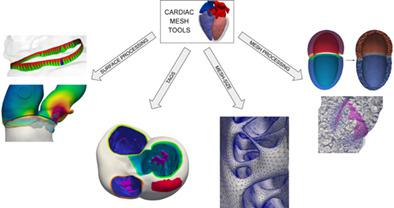当前位置:
X-MOL 学术
›
Int. J. Numer. Method. Biomed. Eng.
›
论文详情
Our official English website, www.x-mol.net, welcomes your
feedback! (Note: you will need to create a separate account there.)
Polygonal surface processing and mesh generation tools for the numerical simulation of the cardiac function
International Journal for Numerical Methods in Biomedical Engineering ( IF 2.2 ) Pub Date : 2021-01-07 , DOI: 10.1002/cnm.3435 Marco Fedele 1 , Alfio Quarteroni 1, 2
International Journal for Numerical Methods in Biomedical Engineering ( IF 2.2 ) Pub Date : 2021-01-07 , DOI: 10.1002/cnm.3435 Marco Fedele 1 , Alfio Quarteroni 1, 2
Affiliation

|
In order to simulate the cardiac function for a patient‐specific geometry, the generation of the computational mesh is crucially important. In practice, the input is typically a set of unprocessed polygonal surfaces coming either from a template geometry or from medical images. These surfaces need ad‐hoc processing to be suitable for a volumetric mesh generation. In this work we propose a set of new algorithms and tools aiming to facilitate the mesh generation process. In particular, we focus on different aspects of a cardiac mesh generation pipeline: (1) specific polygonal surface processing for cardiac geometries, like connection of different heart chambers or segmentation outputs; (2) generation of accurate boundary tags; (3) definition of mesh‐size functions dependent on relevant geometric quantities; (4) processing and connecting together several volumetric meshes. The new algorithms—implemented in the open‐source software vmtk—can be combined with each other allowing the creation of personalized pipelines, that can be optimized for each cardiac geometry or for each aspect of the cardiac function to be modeled. Thanks to these features, the proposed tools can significantly speed‐up the mesh generation process for a large range of cardiac applications, from single‐chamber single‐physics simulations to multi‐chambers multi‐physics simulations. We detail all the proposed algorithms motivating them in the cardiac context and we highlight their flexibility by showing different examples of cardiac mesh generation pipelines.
中文翻译:

用于心功能数值模拟的多边形表面处理和网格生成工具
为了模拟患者特定几何形状的心脏功能,计算网格的生成至关重要。在实践中,输入通常是来自模板几何或医学图像的一组未处理的多边形表面。这些表面需要临时处理以适合体积网格生成。在这项工作中,我们提出了一组旨在促进网格生成过程的新算法和工具。特别是,我们关注心脏网格生成管道的不同方面:(1)心脏几何形状的特定多边形表面处理,如不同心室或分割输出的连接;(2) 生成准确的边界标签;(3) 依赖于相关几何量的网格尺寸函数的定义;(4) 处理和连接几个体积网格。新算法——在开源软件中实现vmtk - 可以相互结合,允许创建个性化的管道,可以针对每个心脏几何形状或要建模的心脏功能的每个方面进行优化。由于这些特征,所提出的工具可以显着加快从单室单物理模拟到多室多物理模拟的大范围心脏应用的网格生成过程。我们详细介绍了在心脏环境中激励它们的所有提议算法,并通过展示心脏网格生成管道的不同示例来强调它们的灵活性。
更新日期:2021-01-07
中文翻译:

用于心功能数值模拟的多边形表面处理和网格生成工具
为了模拟患者特定几何形状的心脏功能,计算网格的生成至关重要。在实践中,输入通常是来自模板几何或医学图像的一组未处理的多边形表面。这些表面需要临时处理以适合体积网格生成。在这项工作中,我们提出了一组旨在促进网格生成过程的新算法和工具。特别是,我们关注心脏网格生成管道的不同方面:(1)心脏几何形状的特定多边形表面处理,如不同心室或分割输出的连接;(2) 生成准确的边界标签;(3) 依赖于相关几何量的网格尺寸函数的定义;(4) 处理和连接几个体积网格。新算法——在开源软件中实现vmtk - 可以相互结合,允许创建个性化的管道,可以针对每个心脏几何形状或要建模的心脏功能的每个方面进行优化。由于这些特征,所提出的工具可以显着加快从单室单物理模拟到多室多物理模拟的大范围心脏应用的网格生成过程。我们详细介绍了在心脏环境中激励它们的所有提议算法,并通过展示心脏网格生成管道的不同示例来强调它们的灵活性。











































 京公网安备 11010802027423号
京公网安备 11010802027423号